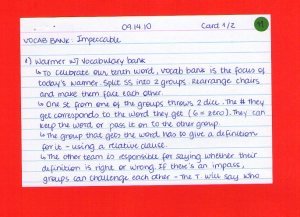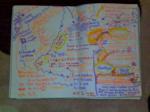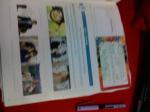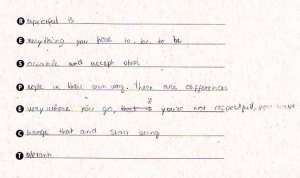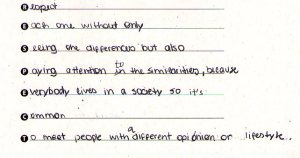It has been a long, looong while since I’ve last written here, in my blog. And before the last time it had also been a long while. I could use this post to explain the reason for the hiatus (which initially I attributed to too much work – which is true – and later I reflected it could have another, a more philosophical one. But that’s a topic for a whole other post, I hope.) But that would make this post too long (and too boring??!?). And I can’t let that happen. Something pushed me to go back to writing today, and I feel if I don’t write about it today the moment will be lost.

Do you believe in magic? (image by http://stillinlovewithu.deviantart.com/art/do-u-believe-in-magic-314637726
Today I had THAT lesson.
How many of you have once (or more than once, or maybe even more often than you’re willing to admit) felt beat? I mean… Feeling demotivated and tired. I wouldn’t go as far as say I felt burned out, but it’s been quite a demanding semester (classes, courses, projects, work-related trips and presentations… all very exciting but also strenuous). Right now we’re just after midterms and we have a shorter semester due to the Football World Cup that’s taking place in less than two months. I had a long day today, full of work, marking, meetings, rushing around, preparing material. Sounds like a lot? Now picture I did all that after having pinched a nerve on my back a couple of days ago. You could say I was wishing for the time of the day where I could go home. I’m not proud of it, but it happens to all of us eventually (especially after 20+ years as a teacher, I suppose.
And then I went into the classroom to teach a group of teens (13-14 years old, about A2 level). It was “report card day”, and I’m pretty strict with grades, so I wasn’t expecting a great class. In their midterms a good portion of the learners had showed some difficulty with the past participle form of the verbs, so I had planned a simple warmer. A tic-tac-toe.
Standard procedure: 11 learners split into two groups. Each number corresponded to the base form of a verb, each group (taking turns) called a number and wrote the past participle form of the verb under it (using a different color – I’m very visual!). After confirmation (by me) that the form was written correctly learners had to (orally) use the verb in a sentence. They got the space if the sentence was correct. I had planned the activity to last about 15 minutes. Nothing much to it, really. Certainly nothing new or exciting.
Oh, yes. I almost forgot. The winning team would win chocolate kisses (Easter surplus).

Give way to a moment? Photo taken from http://flickr.com/eltpics by Dace Parualins, used under a CC Attribution Non-Commercial license, http://creativecommons.org/licenses/by-nc/3.0/
What followed was just magic. I have never seen that group of learners so engaged, excited or – most importantly – speaking as much English as I did. I have no idea why today (maybe a sign from God, wonders the Catholic girl in me?). But they went wild. Groups really interacted at each turn. They negotiated and voiced their opinions, they contested other learner’s suggestions, they ran to stop each other from speaking to then bring the group to confer again. Opposing teams kept talking and discussing spelling and possible sentences while the other was taking its turn. They were on their feet and cheering (in English!) when they were right, they were mumbling and taking guesses at what was wrong when they made a mistake (expecting the other team to make a mistake as well).
Bottom line? The activity lasted 45 minutes. I just let it go. I didn’t get half of my lesson plan done (please do keep in mind I’m on a tight schedule, thanks to football!). Learners didn’t feel time pass. They spoke English naturally and because they had a need they wanted to fill. I even took the time to do a meta-cognitive feedback after it, to elicit from learners what skills (other than English) they had practiced during the activity (e.g. collaboration, negotiation, flexibility, critical thinking, etc…) and share the reason why I had let an activity planned for 15 minutes last for 45 (more, considering the meta-cognitive feedback – and our lessons only last 75 minutes.)
I left the classroom feeling like a million dollars. I was renewed. THAT is the reason I’ve become a teacher. For lessons like this. For seeing learning take place naturally and willingly. For seeing language being needed and found. For helping my learners develop other skills other than the target language (though through it.)
The great feeling did not prevent me from wondering (and these are the questions I post to any of my readers for I’d love to see other outtakes on it):
- Was I right to dismiss my initial plan with very specific teaching goals (and new language) in favor of fluency development?
- How much of the past participles and their use will learners retain?
- One of the 11 learners did not really join in and was mostly just listening to his group. Would he have benefited more from a “normal” lesson?
- What “language gain” did the learners have?
- Why is it that within 5 minutes into the activity I decided I would let it go for as long as it took, as opposed to following my carefully planned, pedagogically-based lesson plan? Was it experience or feeling that gave me that intuition / gut-feeling? How do we know when to stick to the plan and when it’s more beneficial (?!?) to learners to “go with the flow”?
Last thought? Learners didn’t even remember the kisses – even though they were glad to get them! And those chocolate kisses gave me a super sweet, unexpected and yet much needed, teaching moment. Who would have guessed?
By the way: During the hiatus I’ve become a regular blogger – once a month – at Richmond Brazil’s Teacher Share blog. These are the posts I’ve written, if you’re interested:
– Intelligi…What? (about dicovering ELF pronunciation at IATEFL)
– Mind the Gap (about the gap between theory and action in ELT teaching)
– The Invisibility of Being a Teacher (about the depreciation of being a(n ELT teacher)


